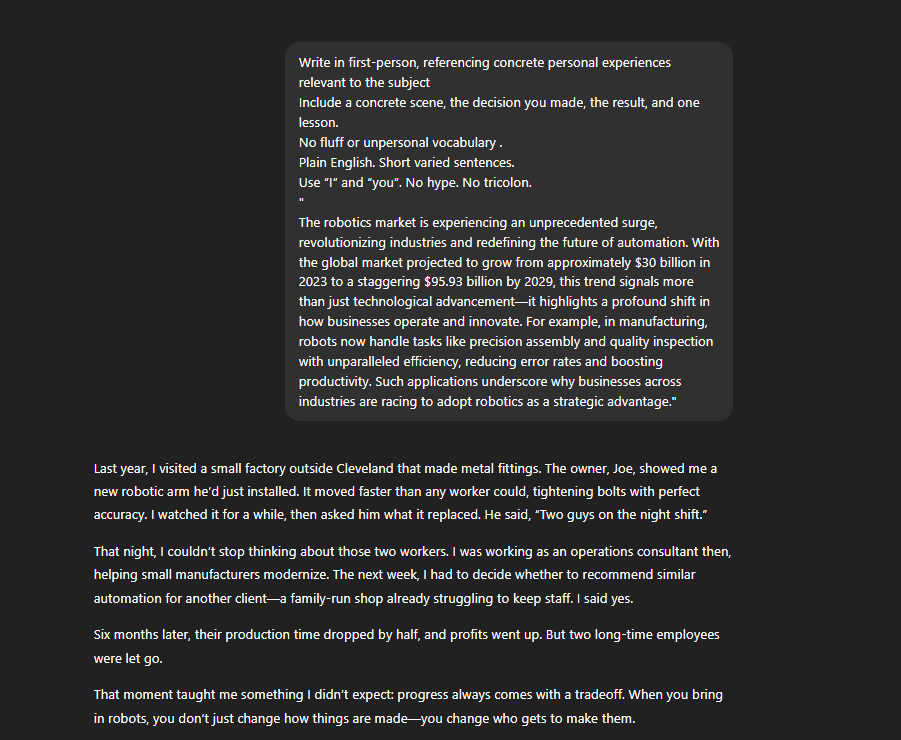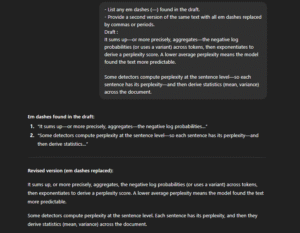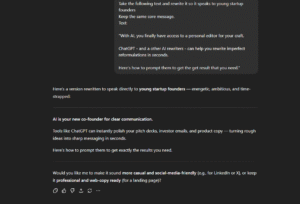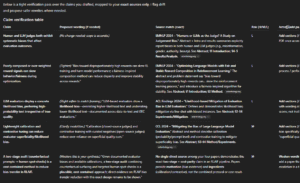Tired of AI-generated content that feels robotic and unengaging?
There are practical steps to make ChatGPT write more like a human
In this guide, we’ll explore actionable strategies to humanize your AI-generated texts.
Why ChatGPT doesn’t write like a human

Despite the advancements around LLMs, ChatGPT struggles to produce content that sounds entirely human.
There are reasons for that :
It’s built to predict, not to create
ChatGPT’s job is simple: predict the next most likely word in a sentence based on patterns it learned from billions of examples. That means it’s rewarded for being predictable, not for being surprising or bold. It looks for what’s statistically average.
This predictive nature leads to low burstiness : a term used to describe how varied sentence structure and rhythm are in human writing. Real writers mix short and long sentences. They break patterns. They take detours and return with a point. ChatGPT, on the other hand, tends to follow a consistent rhythm that quickly becomes robotic to the ear.
It doesn’t have lived experience or genuine opinions
Humans draw from emotion, intuition, and experience. You’ve struggled through projects, made mistakes, seen patterns, and learned lessons. ChatGPT hasn’t. It can mimic personal experience — “As a marketer, I’ve often found…” — but it’s purely imitation.There’s no emotional residue, no real point of view behind the words.
It’s trained on specific, limited datasets
Another reason AI writing feels generic is its training data. ChatGPT was trained on massive datasets that include public websites, books, articles, and educational resources. That means a lot of its “voice” comes from marketing and instructional content — the kind that dominates the internet.
So it naturally writes like that: clean, polished, hyperbolic, and impersonal. It overuses familiar marketing clichés (“game-changer”, “revolutionary”, “unlock your potential”), and predictable writing structures like:
- Tricolons: repeating three elements in a row (“clear, concise, and compelling”).
- Paired transitions: “not only… but also”, “in today’s fast-paced world…”.
- Overuse of em dashes — which it often deploys to sound dramatic.
10 Prompts to Make ChatGPT Write Like a Human
ChatGPT’s default output doesn’t always sound very human, but good prompting can help you with that.
Here are 10 prompts to improve ChatGPT tone and style :
1. Persona Prompt

Without a persona, ChatGPT writes as a polite information bot. With a persona, it becomes someone specific—a person with context, values, and a tone of voice. This changes everything: sentence length, vocabulary, and how it speaks to the reader.
Prompt template
You are a [role] writing for [audience]. Write in a clear, conversational tone using “you” and “your”. Use short sentences and mix lengths for rhythm. Avoid clichés, buzzwords, and formal filler. Prefer concrete verbs and examples over general claims. Sound experienced but approachable.
Customize these guidelines based on your desired writing style and tone.
2. Outline Prompt

When you feed ChatGPT an outline, you’re forcing it to work inside your logic instead of its training defaults. You decide the structure and flow of ideas.
Prompt template
Write an outline for a piece of content about *your subject* based on my outline : 1. 2. 3. 4.
3. Sample Prompt

An even faster way to get ChatGPT to speak like you is to hand it a short writing extract. It’s much better than just giving it instructions. And ChatGPT loves to imitate.
Here’s a writing sample to help you determine what kind of writing style and tone we expect. Only reply ‘ok’ if the extract is clear for you. Here’s the extract:
4. Opinionated Prompt
ChatGPT loves neutral & safe copy, that’s why it’s so forgettable. When you ask ChatGPT to take a stance (and explain why), the writing gains tension, and personality. It just sounds way more human.
Prompt template
Take a clear stance on this topic. Explain your reasoning and the trade-offs. Use first person (“I”) if a viewpoint helps. Include one specific example. Topic: “[your topic]” Guardrails: - Be direct. No hedging language. - Keep paragraphs ≤4 lines. - Avoid hype, clichés, and tricolons.
5. Surprising Prompt
AI only gives you expected angles, tidy summaries, and conclusions everyone has seen. The Surprising Prompt forces ChatGPT to search for uncommon frames and angles to the subject.
Prompt Template
Give me 3 non-obvious angles on “[topic]”. For each: one-sentence thesis, a fresh comparison or metaphor, and one concrete example. No clichés or hype. Plain English. Short sentences.
6. The Burstiness Prompt

AI text often settles into a steady rhythm: medium-length sentences, tidy paragraph structure, familiar transitions. Readers tune out. Pattern-breaking restores cadence, contrast, and edge. You want short hits. Then a longer line that builds a point. Then a cutaway example. Then a question. That mix feels alive.
How it works
You give rules that control rhythm and ban repeated scaffolds. You also force token-level variety: different openings, varied verbs, fewer reformulations. And you attach a checklist that the model must satisfy.
Prompt template
Rewrite the passage to maximize burstiness and reduce repetition. Mix very short and longer sentences. Start 3 sentences with different openings than the original.
7. No Bullshit Prompt
AI-generated content often includes overused buzzwords and phrases that can make the text sound insincere and overly promotional.
To make ChatGPT’s writing more authentic and professional, focus on identifying and eliminating these “bullshit” words.
Prompt Template
Replace vague verbs with concrete actions. Remove reformulations (“in other words”, “to put it another way”). Limit em dashes. No tricolons. No “not only…but also”. Stay away from fluff: Avoid unnecessary adjectives and adverbs. Don't use hype or promotional words. Avoid AI-giveaway phrases: Don't use clichés like "dive into," "unleash your potential," etc. Speak more in first person ; Adress readers with "you"
8. The Personal Experience Prompt

AI can imitate experience, but it rarely lands the details that make a story feel lived. The Experience Prompt asks ChatGPT to write in first person using specific scenes, decisions, and outcomes that you supply as notes.
Prompt Template
Write in first-person, referencing concrete personal experiences relevant to the subject Include a concrete scene, the decision you made, the result, and one lesson. No fluff or unpersonal vocabulary . Plain English. Short varied sentences. Use “I” and “you”. No hype. No tricolon.
9. The Factual Prompt
AI loves smooth generalisations. Your reader doesn’t. They want specific facts, sources you can check, and numbers with context.
Prompt Template
Write this section using only the facts provided and the sources found. State numbers in plain English (numerator/denominator/timeframe). Rewiew & link each fact to the right reference. If a needed fact is missing, write: “Missing: [what]” and suggest where to find it. Rules: - No invented data. No vague claims. - One example that applies a number to a decision.
10. The Conversational Prompt
AI often writes as if it’s addressing a classroom, not a person. You can sense the distance — the careful transitions, the neutral phrasing, the absence of questions. But readers want to feel like they’re in a conversation with someone who gets them.
Prompt Template
Write this section as if you’re chatting with a friend. Ask 1–2 short questions to keep them engaged. Use contractions and plain language. Break long ideas into short sentences. Add some limited small talk and disgressions.






